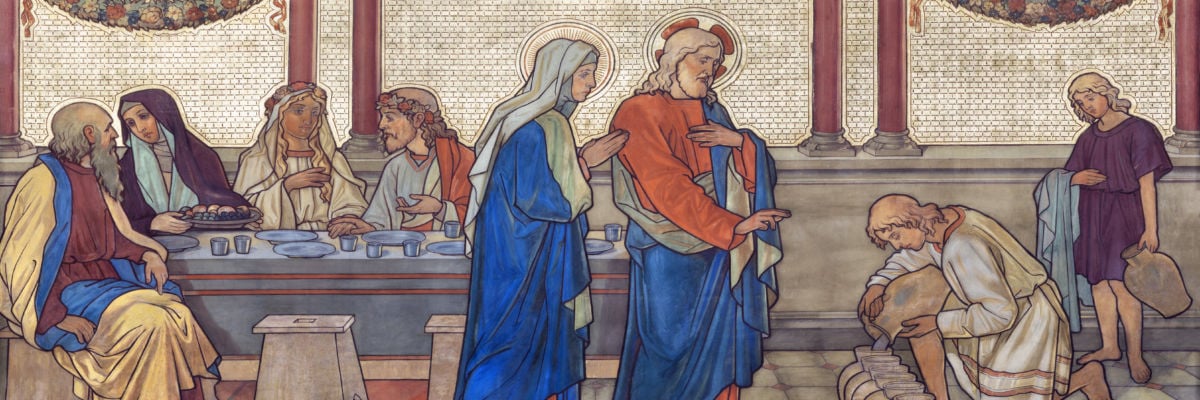
Homily for the Second Sunday in Ordinary Time, 2022
There was a wedding at Cana in Galilee,
and the mother of Jesus was there.
Jesus and his disciples were also invited to the wedding.
When the wine ran short,
the mother of Jesus said to him,
“They have no wine.”
And Jesus said to her,
“Woman, how does your concern affect me?
My hour has not yet come.”
His mother said to the servers,
“Do whatever he tells you.”
Now there were six stone water jars there for Jewish ceremonial washings,
each holding twenty to thirty gallons.
Jesus told them,
“Fill the jars with water.”
So they filled them to the brim.
Then he told them,
“Draw some out now and take it to the headwaiter.”
So they took it.
And when the headwaiter tasted the water that had become wine,
without knowing where it came from
— although the servers who had drawn the water knew —,
the headwaiter called the bridegroom and said to him,
“Everyone serves good wine first,
and then when people have drunk freely, an inferior one;
but you have kept the good wine until now.”
Jesus did this as the beginning of his signs at Cana in Galilee
and so revealed his glory,
and his disciples began to believe in him.-John 2:1-11
The Christmas season is a bit untidy toward its end. Officially in the current liturgy, the Christmas and Epiphany seasons are over and we are now in the period called flatly Per annum, or as it is rendered in English rather more blandly still, “Ordinary Time.”
Yet there is nothing “ordinary” about Ordinary Time. The shining themes of today’s Gospel show us how, in the person and role of the lovely mother of the Savior. We spent the Advent and Christmas seasons in her company, and now she ushers in the rest of the year with her presence and powerful influence. The Gospels that follow Epiphany and the Baptism of the Lord continue to follow the theme of the manifestation (for that is what “Epiphany” means) of the Lord.
We were given notice of this on the feast of the Epiphany, when the Church sang, in the antiphon for the Canticle of Mary for Evening Prayer, this summary of the mysteries recalled that day:
We observe this holy day, ornamented with three miracles:
Today a star led the Magi to the manger;
Today wine was made from water at the wedding;
Today in the Jordan Christ desired to be baptixed by John,
so that he might save us, Alleluia.
And so the Christmas season ends with the feast of the Lord’s baptism, and then the following Sundays, now called Sundays in Ordinary Time, begin with the mystery of Christ’s first public miracle at Cana in Galilee, familiar to us now as the second Luminous Mystery of the holy rosary.
The rosary puts us in mind of the best possible way to enter into the full swing of the new year and our “ordinary” life, and this mystery of the Miracle at the Wedding at Cana shows us just how to approach the rosary, or whatever manner we choose to unite ourselves to the mother of the Savior.
St. Thomas tells us that Mary is there to provide for and obtain the miracle; she is its procuratrix, which in Latin means precisely one with the office of provider or obtainer.
How does she do this? She acts as a go-between, a mediatress, in Latin mediatrix. This word also literally means one who is in-between. Our Lady doesn’t meddle in her Son’s affairs, rather she freely involves herself with quiet confidence.
But what does a mediatress do? She, Thomas tells us, first asks of her son—he says she “calls upon” him for what she hopes—for the thing she mercifully desires to obtain for those in need. Then, second, she instructs Christ’s servants what to do: simply and universally “Do whatever he tells you.”
This is the model of all the righteous intercession of the saints of God, first among whom is his Blessed Mother. It includes the desire to obtain good things for us in mercy, this same desire expressed in their calling upon the Lord before his heavenly altar, and then the confirmation of their power to help by their example and command that we obey the Lord as the first condition of obtaining the object of our prayed-for desire.
Our Lady is the perfect company for us in our needs for the coming year. She will provide, mediate, pray, and command according to the model of today’s mystery. Let us fly to her patronage, but realize even more that in today’s Gospel she began to pray for the needs of her hosts before they knew of their need.
In this she is the best of mothers. As she is always mercifully noticing our needs, let us eagerly look to her to see what the Lord is telling us to do, and the wonderful wine of his mercies, spiritual and material, a fine cup of which he will offer us through her, daily as the year of grace 2022 rolls on.



